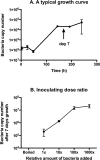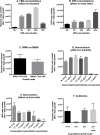Improved Quantification, Propagation, Purification and Storage of the Obligate Intracellular Human Pathogen Orientia tsutsugamushi
- PMID: 26317517
- PMCID: PMC4552649
- DOI: 10.1371/journal.pntd.0004009
Improved Quantification, Propagation, Purification and Storage of the Obligate Intracellular Human Pathogen Orientia tsutsugamushi
Abstract
Background: Scrub typhus is a leading cause of serious febrile illness in rural Southeast Asia. The causative agent, Orientia tsutsugamushi, is an obligate intracellular bacterium that is transmitted to humans by the bite of a Leptotrombidium mite. Research into the basic mechanisms of cell biology and pathogenicity of O. tsutsugamushi has lagged behind that of other important human pathogens. One reason for this is that O. tsutsugamushi is an obligate intracellular bacterium that can only be cultured in mammalian cells and that requires specific methodologies for propagation and analysis. Here, we have performed a body of work designed to improve methods for quantification, propagation, purification and long-term storage of this important but neglected human pathogen. These results will be useful to other researchers working on O. tsutsugamushi and also other obligate intracellular pathogens such as those in the Rickettsiales and Chlamydiales families.
Methodology: A clinical isolate of O. tsutsugamushi was grown in cultured mouse embryonic fibroblast (L929) cells. Bacterial growth was measured using an O. tsutsugamushi-specific qPCR assay. Conditions leading to improvements in viability and growth were monitored in terms of the effect on bacterial cell number after growth in cultured mammalian cells.
Key results: Development of a standardised growth assay to quantify bacterial replication and viability in vitro. Quantitative comparison of different DNA extraction methods. Quantification of the effect on growth of FBS concentration, daunorubicin supplementation, media composition, host cell confluence at infection and frequency of media replacement. Optimisation of bacterial purification including a comparison of host cell lysis methods, purification temperature, bacterial yield calculations and bacterial pelleting at different centrifugation speeds. Quantification of bacterial viability loss after long term storage and freezing under a range of conditions including different freezing buffers and different rates of freezing.
Conclusions: Here we present a standardised method for comparing the viability of O. tsutsugamushi after purification, treatment and propagation under various conditions. Taken together, we present a body of data to support improved techniques for propagation, purification and storage of this organism. This data will be useful both for improving clinical isolation rates as well as performing in vitro cell biology experiments.
Conflict of interest statement
The authors have declared that no competing interests exist.
Figures







Similar articles
-
Bacterial microbiome of the chigger mite Leptotrombidium imphalum varies by life stage and infection with the scrub typhus pathogen Orientia tsutsugamushi.PLoS One. 2018 Dec 6;13(12):e0208327. doi: 10.1371/journal.pone.0208327. eCollection 2018. PLoS One. 2018. PMID: 30521561 Free PMC article.
-
Orientia tsutsugamushi infection reduces host gluconeogenic but not glycolytic substrates.Infect Immun. 2024 Nov 12;92(11):e0028424. doi: 10.1128/iai.00284-24. Epub 2024 Sep 26. Infect Immun. 2024. PMID: 39324805 Free PMC article.
-
Occurrence of Orientia tsutsugamushi, the Etiological Agent of Scrub Typhus in Animal Hosts and Mite Vectors in Areas Reporting Human Cases of Acute Encephalitis Syndrome in the Gorakhpur Region of Uttar Pradesh, India.Vector Borne Zoonotic Dis. 2018 Oct;18(10):539-547. doi: 10.1089/vbz.2017.2246. Epub 2018 Jul 17. Vector Borne Zoonotic Dis. 2018. PMID: 30016222
-
Orientia tsutsugamushi: An Unusual Intracellular Bacteria-Adaptation Strategies, Available Antibiotics, and Alternatives for Treatment.Curr Microbiol. 2024 Jun 21;81(8):236. doi: 10.1007/s00284-024-03754-1. Curr Microbiol. 2024. PMID: 38907107 Review.
-
An Update on Host-Pathogen Interplay and Modulation of Immune Responses during Orientia tsutsugamushi Infection.Clin Microbiol Rev. 2018 Jan 31;31(2):e00076-17. doi: 10.1128/CMR.00076-17. Print 2018 Apr. Clin Microbiol Rev. 2018. PMID: 29386235 Free PMC article. Review.
Cited by
-
Dysregulated Th1 Immune and Vascular Responses in Scrub Typhus Pathogenesis.J Immunol. 2018 Feb 15;200(4):1233-1240. doi: 10.4049/jimmunol.1701219. J Immunol. 2018. PMID: 29431689 Free PMC article. Review.
-
Orientia tsutsugamushi Nucleomodulin Ank13 Exploits the RaDAR Nuclear Import Pathway To Modulate Host Cell Transcription.mBio. 2021 Aug 31;12(4):e0181621. doi: 10.1128/mBio.01816-21. Epub 2021 Aug 3. mBio. 2021. PMID: 34340535 Free PMC article.
-
Evidence for a peptidoglycan-like structure in Orientia tsutsugamushi.Mol Microbiol. 2017 Aug;105(3):440-452. doi: 10.1111/mmi.13709. Epub 2017 Jun 19. Mol Microbiol. 2017. PMID: 28513097 Free PMC article.
-
Methods to monitor bacterial growth and replicative rates at the single-cell level.FEMS Microbiol Rev. 2022 Nov 2;46(6):fuac030. doi: 10.1093/femsre/fuac030. FEMS Microbiol Rev. 2022. PMID: 35772001 Free PMC article. Review.
-
Orientia tsutsugamushi selectively stimulates the C-type lectin receptor Mincle and type 1-skewed proinflammatory immune responses.PLoS Pathog. 2021 Jul 28;17(7):e1009782. doi: 10.1371/journal.ppat.1009782. eCollection 2021 Jul. PLoS Pathog. 2021. PMID: 34320039 Free PMC article.
References
-
- Ellis RD, Fukuda MM, McDaniel P, Welch K, Nisalak A et al. (2006) Causes of fever in adults on the Thai-Myanmar border. Am J Trop Med Hyg 74: 108–113. - PubMed
Publication types
MeSH terms
Grants and funding
LinkOut - more resources
Full Text Sources
Other Literature Sources

